#prr gg1
Text
I need to tidy up my apartment more so I can run my HO scale GG1 around the place instead of being depressed about my own prospects, honestly
10 notes
·
View notes
Text





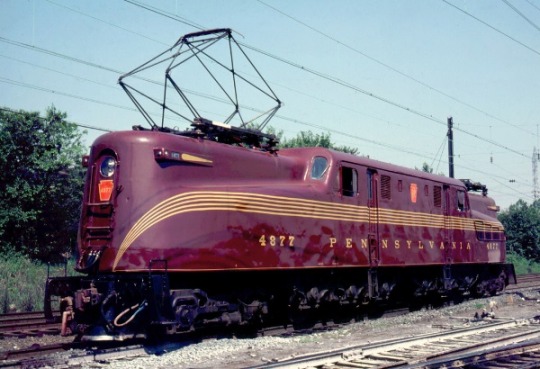
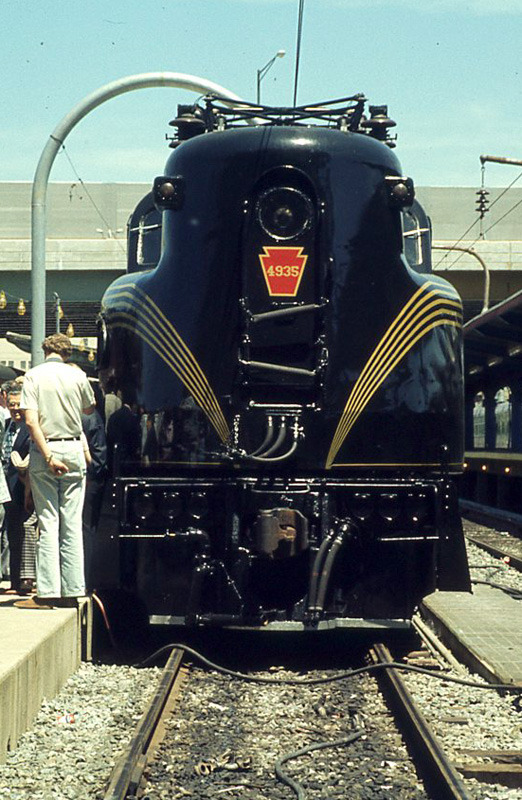
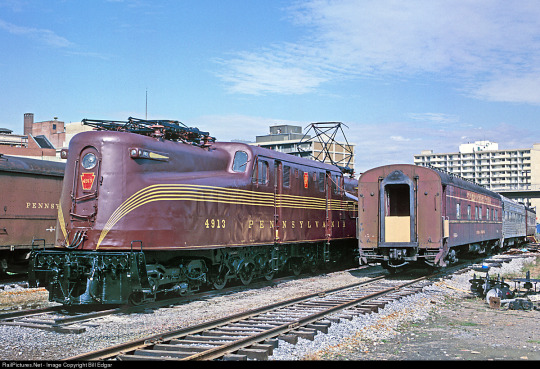
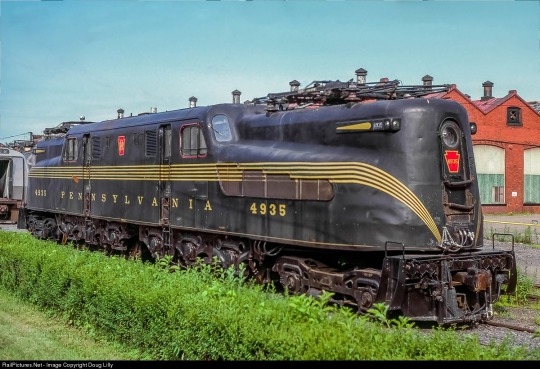

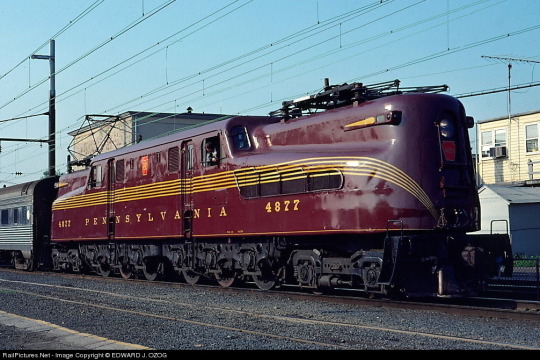

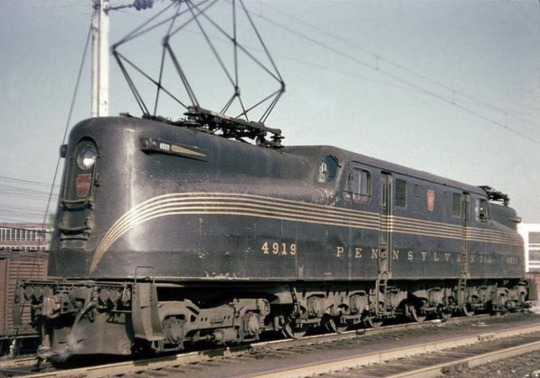
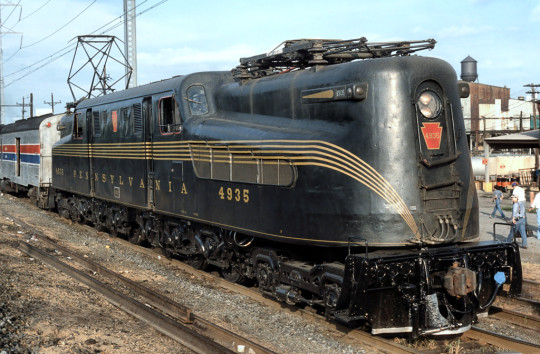
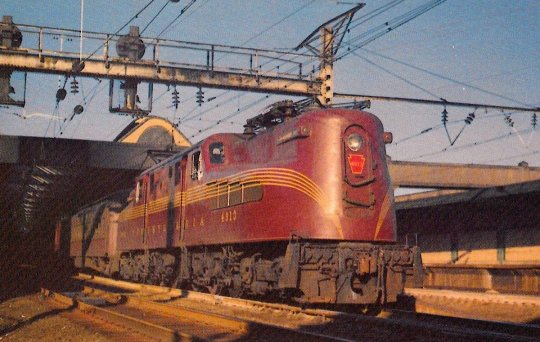
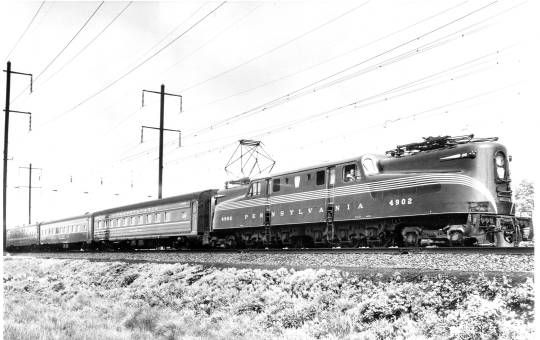
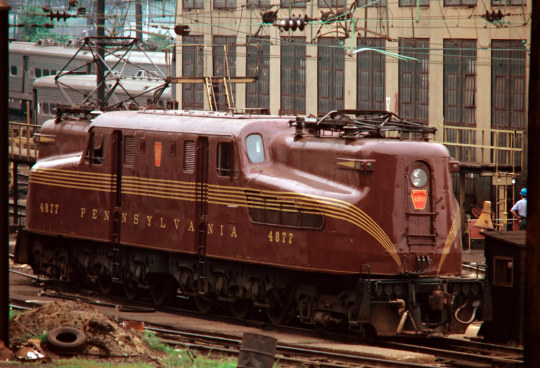








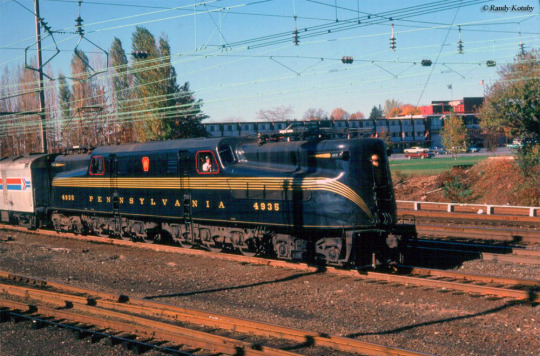
Now here we have the iconic Pennsylvania Railroad GG1 electric locomotives. There are four of them in my roster of TTTE OC engines from the PRR: Glenn (brunswick green five-stripe #4927), Gracie (tuscan red five-stripe #4877), Garrison (brunswick green five-stripe #4919), and Gaby (tuscan red five-stripe #4913). And these images will be here for Grantgfan to use when the time comes.
#pennsylvania railroad#prr#gg1#prr gg1#electric locomotive#electric engine#passenger cars#passenger train#train#trains#ttte oc#ttte#thomas and friends#thomas the tank engine
33 notes
·
View notes
Photo
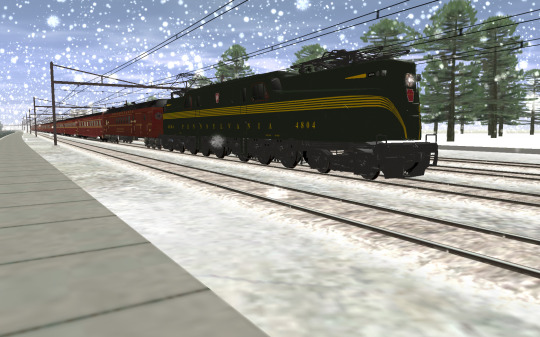
Day 15: Pennsylvania Railroad GG1
Information from Wikipedia:
The PRR GG1 was a class of electric locomotives built for the Pennsylvania Railroad (PRR), in the northeastern United States. Between 1934 and 1943 General Electric and the PRR's Altoona Works built 139 GG1s.
The GG1 entered service with the PRR in 1935 and later ran on successor railroads Penn Central, Conrail and Amtrak. The last GG1 was retired by New Jersey Transit in 1983. Most have been scrapped, but sixteen are in museums.
The GG1 was 79 feet 6 inches (24.23 m) long and weighed 475,000 pounds (215,000 kg). The frame of the locomotive was in two halves joined with a ball joint, allowing the locomotive to negotiate sharper curves. The body rested on the frame and was clad in welded steel plates. The control cabs were near the center of the locomotive on each side of the main oil-cooled transformer and oil-fired train-heating boiler. This arrangement, first used on the PRR's Modified P5 class, provided for greater crew safety in a collision and provided for bi-directional operation of the locomotive. Using Whyte notation for steam locomotives, each frame is a 4-6-0 locomotive, which in the Pennsylvania Railroad classification system is a "G". The GG1 has two such frames back to back, 4-6-0+0-6-4. The related AAR wheel arrangement classification is 2-C+C-2. This means one frame mounted upon a set of two axles unpowered (the "2") and three axles powered (the "C") hinged with the ball and socket to another frame of the same design (the +). The unpowered "2" axles are at either end of the locomotive. The GG1 was equipped with a Leslie A200 horn.
A pantograph on each end of the locomotive body was used to collect the 11,000 V, 25 Hz alternating current (AC) from the overhead catenary wires. In operation, the leading pantograph was usually kept lowered and the trailing one raised to collect current, since if the rear pantograph failed it would not strike the forward pantograph. A transformer between the two cabs stepped-down the 11,000 V to the voltages needed for the traction motors and other equipment. Twelve 385-horsepower (287 kW) GEA-627-A1 traction motors (AC commutator motors, not AC induction motors) drove the GG1's 57-inch (1,448 mm) diameter driving wheels on six axles using a quill drive. The power required was such that double traction motors were used, with two motors driving each axle. The traction motors were six-pole field, 400 volts, 25 Hz rated each at 385 hp (287 kW). The motors were frame-mounted using quill drives to the sprung driving wheels, providing a flexible suspension system across a relatively-long locomotive frame, which allowed full wheel weight to rest on the rail for good traction regardless of track condition. A series-wound commutator motor's speed is increased by increasing the applied voltage to the motor, thus increasing the current through the motor's armature, which is necessary for increasing its torque and thus increasing motor speed. The engineer's cab had a 21-position controller for applying voltage to the motors. Four unpowered leading/trailing wheels were mounted on each end of the locomotive.
In the 1930s, railroad passenger cars were heated with steam from the locomotive. The GG1 had an oil-fired steam generator to feed its train's "steam line."
Beginning in the late 1910s, the PRR received the FF1, but decided that it was too slow for passenger trains; it was relegated to heavy freight service. In the mid-1920s, it received the L5 electric, which had a third-rail power supply at the time. When the Pennsylvania built the O1 and the P5, it chose the P5 over the O1 for its ability and power on the rails. After a grade-crossing accident with the P5, the cab was moved to the center and was designated P5a. PRR still searched for the ultimate electric, since the P5 did not track well at high speeds and was wondering if the P5a could be improved even further. Soon enough, the Pennsylvania was in luck and found two contacts as early as 1932. The mechanical design of the GG1 was based largely on the EP3, which the PRR had borrowed from the New York, New Haven & Hartford Railroad to compare it to the P5a. In 1933, the PRR decided to replace its P5a locomotives; it asked General Electric and Westinghouse to design prototype locomotives with a lighter axle load and more power than the P5a, a top speed of at least 100 miles per hour (160 km/h), a streamlined body design, and a single (central) control cab.
Both companies delivered their prototypes to PRR in August 1934. Westinghouse's R1 was essentially "little more than an elongated and more powerful version of the P5a" with an AAR wheel arrangement of 2-D-2. General Electric delivered its GG1. Both locomotives were tested for ten weeks in regular service between New York and Philadelphia and on a test track in Claymont, Delaware. PRR chose the GG1 because the R1's rigid wheelbase prevented it from negotiating sharp curves and some railroad switches. On November 10, 1934, the railroad ordered 57 locomotives: 14 assembled by General Electric in Erie, 18 by the PRR's own Altoona Works, and 20 more in Altoona with electrical components from Westinghouse in East Pittsburgh and chassis from the Baldwin Locomotive Works in Eddystone. An additional 81 locomotives were built at Altoona between 1937 and 1943.
On January 28 1935, to mark the completion of electrification of the line from Washington, D.C., to New York City, PRR ran a special train hauled by Pennsylvania Railroad 4800 before it opened the line for revenue service on February 10. It made a round-trip from D.C. to Philadelphia; it completed the return leg in a record 1 hour and 50 minutes.
In 1945, a Pennsylvania GG1 hauled the funeral train of President Franklin D. Roosevelt from Washington Union Station to New York Pennsylvania Station.
In the mid-1950s, with declining demand for passenger train service, GG1s 4801–4857 were re-geared for a maximum speed of 90 miles per hour (140 km/h) and placed in freight service. They initially retained their train-heating steam generator, and were recalled to passenger service for holiday-season mail trains and 'Passenger Extras' such as those run for the annual Army–Navy football game in Philadelphia.
Timetable speed limit for the GG1 was 75-80 mph until October 1967, when some were allowed 100 mph for a couple of years. When Metroliner cars were being overhauled in the late 1970s, GG1s were again allowed 100 mph for a short time when hauling Amfleet cars on trains scheduled to run 226.6 miles from New York to Washington in 3 hours and 20 to 25 minutes.
On June 8, 1968, two Penn Central GG1s hauled Robert F. Kennedy's funeral train from New York Penn Station to Washington, D.C.
The first designer for the GG1 project was industrial designer Donald Roscoe Dohner, who produced initial scale-styling models, although the completed prototype looked somewhat different. At some point, PRR hired famed industrial designer Raymond Loewy to "enhance the GG1's aesthetics." The final design is retrospectively 'Art Deco' as we know it today.
Although it was thought until 2009 that Loewy was solely responsible for the GG1's styling, Dohner is now understood to have contributed as well. (Dohner's GG1 designs influenced the modified P5as, which debuted before the GG1 — not, as was thought, the other way around.) Loewy did claim that he recommended the use of a smooth, welded body instead of the riveted one used in the prototype. Loewy also added five gold pinstripes and a Brunswick green paint scheme.
In 1952, the paint scheme was changed to Tuscan red; three years later, the pinstripes were simplified to a single stripe and large red keystones were added.
On September 6 1943, the Congressional Limited crashed at Frankford Junction, in the Kensington neighborhood of Philadelphia, Pennsylvania, in the United States. The train was pulled by GG1 4930. The accident was caused by a journal box fire (a hot box) on the front of the seventh of the train's 16 cars. The journal box seized and an axle snapped, catching the underside of the truck and catapulting the car upwards. It struck a signal gantry, which peeled off its roof along the line of windows "like a can of sardines". Car #8 wrapped itself around the gantry upright in a figure U. The next six cars were scattered at odd angles over the tracks, and the last two cars remained undamaged. In total, 79 passengers died, all from cars #7 and #8, and 117 were injured, some seriously.
On January 15 1953, train 173, the overnight Federal from Boston, was approaching Washington behind GG1 4876. The train passed a signal 2.1 miles (3.4 km) north of Union Station between 60 and 70 miles per hour (97 and 113 km/h), and the engineer decreased the throttle and started applying the brakes. When the engineer realized that the train was not slowing down, and applying the emergency brake had no effect, he sounded the engine's horn. A signalman, hearing the horn and noting the speed of the 4876, phoned ahead to the station master's office. 4876 negotiated several switches at speeds well over the safe limits and entered the station at around 35 to 40 miles per hour (56 to 64 km/h). The train demolished the bumping post, continued through the station master's office and into the concourse, where it fell through the floor into the station's basement. Thanks to the evacuation of the concourse, no one died, either in the station or aboard the train. A temporary floor was erected over the engine, and the hole it created, for the inauguration of President Dwight D. Eisenhower. 4876 was eventually dismantled, removed from the basement and reassembled with a new frame and superstructure in Altoona. The reconstructed 4876 survives at the B&O Railroad Museum in Baltimore.
The accident was determined to have been caused by a closed "angle cock", a valve on the front and rear of all locomotives and rail cars used in the train's airbrake system, on the rear of the third car in the train. The handle of the angle cock had been improperly placed and had contacted the bottom of the car. Once it was closed, the air brake pipe on all the cars behind the closed valve remained at full pressure, keeping the brakes released on those cars while the brakes on the locomotive and first three cars were applied in emergency. The only major electro-mechanical breakdown of the GG1 was caused by a February 1958 blizzard that swept across the northeastern United States and put nearly half of the GG1s out of commission. Exceptionally fine snow, caused by the extreme low temperatures, passed through the traction motors' air filters and into the electrical components. When the snow melted, it short-circuited the components. On about 40 units, the air intakes were later moved to a position under the pantographs.
In 1968, the PRR, with its 119 surviving GG1s, merged with the New York Central Railroad to form Penn Central. Penn Central went bankrupt in 1970 and its freight operations were later assumed by government-controlled Conrail, which used 68 GG1s in freight service until the end of electric freight traction in 1980.
After its creation in 1971, Amtrak purchased 30 GG1s for $50,000 each and leased another 21, of which 11 were for use on New York and Long Branch commuter trains. Amtrak initially renumbered the purchased GG1s as Nos. 900 to 929; later the railroad added a prefixed "4". This replicated some of the numbers of the leased units, which were renumbered 4930 to 4939, except 4935, which kept its old PRR/PC number.
Amtrak unsuccessfully attempted to replace the GG1s in 1975 with the General Electric E60. An E60 derailed during testing at 102-mile-per-hour (164 km/h), forcing an investigation (the E60 used the same trucks as the P30CH diesel then in service with Amtrak) that delayed acceptance. The hoped-for 120 miles per hour (193 km/h) service speed was never achieved (timetable limit was 90 mph, then 80, then 90).
A replacement was finally found after Amtrak imported and tested two lightweight European locomotives: X995, an Rc4a built by ASEA of Sweden, and X996, a French design. The railroad picked the ASEA design, initially nicknamed the "Swedish swifty" or the "Mighty Mouse" and later often referred to as the "Swedish Meatball". Electro-Motive Diesel, then a part of General Motors, was licensed to build a derivative called the AEM-7. As AEM-7s arrived, Amtrak finally ended GG1 service on April 26, 1980.
The last GG1s in use were some of the 13 assigned to New Jersey Transit (#4872–4884) for its North Jersey Coast Line between New York and South Amboy (the former New York and Long Branch) that ran until October 29, 1983, thus retiring the locomotive after 49 years of service.
Fifteen production locomotives and the prototype were preserved in museums. None are operational; their main transformers were removed because of the PCBs in the insulating oil.
PRR/PC/CR 4800 — Railroad Museum of Pennsylvania, Strasburg, Pennsylvania (nicknamed "Old Rivets" due to it being the only GG1 to have been built with a riveted body)
PRR/PC/CR 4859 — Transportation Center, Harrisburg, Pennsylvania (designated Pennsylvania State electric locomotive in 1987)
PRR/PC/CR/NJT 4876 — B&O Railroad Museum, Baltimore, Maryland (Reconstructed with new frame and superstructure as well as reusable components from the original 4876 following the 1953 Washington Union Station wreck)
PRR/PC/CR/NJT 4877 — United Railroad Historical Society of New Jersey, Boonton, New Jersey (nicknamed "Big Red")
PRR/PC/CR/NJT 4879 — United Railroad Historical Society of New Jersey, Boonton, New Jersey
PRR/PC/CR/NJT 4882 — National New York Central Railroad Museum, Elkhart, Indiana (currently painted in Penn Central colors)
PRR/Amtrak 4890 — National Railroad Museum, Green Bay, Wisconsin
PRR 4903/Amtrak (4)906 — Museum of the American Railroad, Frisco, Texas (hauled Robert F. Kennedy's funeral train with GG1 4901 from New York to Washington on June 8, 1968).
PRR 4909/Amtrak 4932 — Leatherstocking Railway Museum, Cooperstown Junction, New York
PRR 4913/Amtrak (4)913 — Railroaders Memorial Museum, Altoona, Pennsylvania
PRR 4917/Amtrak 4934 — Leatherstocking Railway Museum, Cooperstown Junction, New York
PRR 4918/Amtrak (4)916 — National Museum of Transportation, St Louis, Missouri
PRR 4919/Amtrak (4)917 — Virginia Museum of Transportation, Roanoke, Virginia
PRR 4927/Amtrak 4939 — Illinois Railway Museum, Union, Illinois
PRR 4933/Amtrak (4)926 — Central New York Chapter of the National Railroad Historical Society, Syracuse, New York. It has been cosmetically restored and is on display at the NYS Fairgrounds Historic Train Exhibit.
PRR 4935 / Amtrak 4935 — Railroad Museum of Pennsylvania, Strasburg, Pennsylvania (nicknamed "Blackjack")
During the mid-1930s, many railroads streamlined locomotives and passenger cars to convey a fashionable sense of speed. While the Union Pacific had the M-10000 and the Chicago, Burlington & Quincy Railroad the Zephyr, the PRR had the GG1. The GG1 has "shown up over the years in more advertisements and movie clips than any other locomotive." It was also featured in art calendars provided by PRR, which were used to "promote its reputation in the public eye."
PRR-painted GG1s appear in the films Broadway Limited in 1941, The Clock in 1945, Blast of Silence in 1961, the 1962 version of The Manchurian Candidate, and Avalon in 1990. Two GG1s appear in the 1973 film The Seven-Ups—a black Penn Central locomotive and a silver, red and blue Amtrak locomotive. A Penn Central GG1 also appears in another 1973 film The Last Detail. PRR GG1 4821 appears briefly in the 1952 film The Greatest Show on Earth, hauling the Ringling Bros. Barnum & Bailey Circus into Philadelphia's Greenwich Yard, as the movie's director Cecil B. DeMille narrates the scene of its arrival. Near the end of the 1951 film Bright Victory, GG1 #4849 is shown pulling into the station.
A GG1 and the Congressional were featured on a postage stamp as part of the United States Postal Service's All Aboard! 20th Century American Trains set in 1999.
The PC games Railroad Tycoon II, Railroad Tycoon 3, Sid Meier's Railroads!, Train Fever, Transport Fever and Transport Fever 2 allow players to purchase and operate GG1 locomotive engines on their train routes. The GG1 is also available with the default Trainz Simulator Games in recent years, and is available as add-ons for Railworks, Train Simulator by Dovetail Games and Microsoft Train Simulator.
Model GG1s have been produced in G, O, S, HO, N and Z scales by Rivarossi, Bachmann, Tyco, Lionel, MTH, USA Trains, Kato, Astor, Fine Art Models, Marklin and other manufacturers.
models and route by: Protrainz, Auran, and Download Station
#PRR#Pennsylvania Railroad#Pennsy#PRR GG1#Pennsylvania Railroad GG1#GG1#Electric Locomotive#Trains#Trainz Simulator#Advent Calendar#Christmas#Christmas 2022 🎄🎅🎁
5 notes
·
View notes
Note
I wasn’t originally a fan of the GG1, but after I found a model of it in a thrift store, it’s grown on me

One of the best electric locomotives of all time. The GG1's are iconic for a reason.
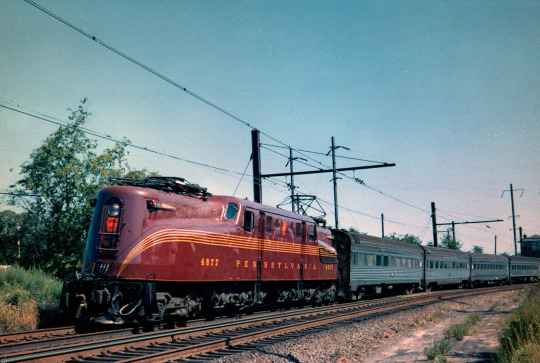
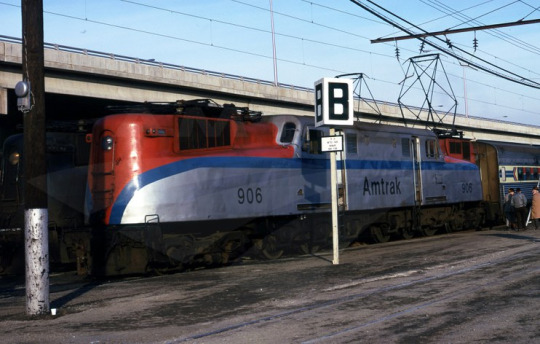
I love these. its a shame we may never see one run again (their electronics are long shot, and would need complete redesigning to be allowed to run under modern railroad safety)
10 notes
·
View notes
Text
The toaster's first day
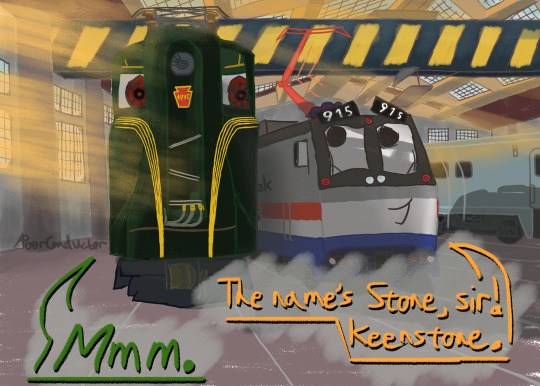
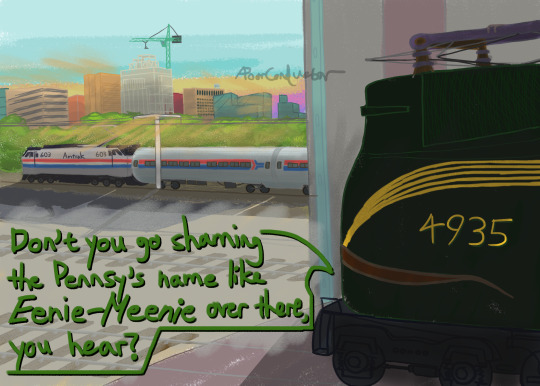
Anthropomorphic Amtrak art, enjoy! I'll try not to wait two months between announcing the next installment and posting it lel
4 notes
·
View notes
Text

Jeff "Jdelhaye" on rypn.org forums.
27 notes
·
View notes
Video
Pennsylvania Railroad - PRR Class GG1 locomotive Nr. 4902 and The Broadway Limited by Historical Railway Images
Via Flickr:
The last all-Pullman train in the United States. Seen here in 1950 in New Jersey www.steamlocomotive.com/GG1/
This is electric railroad purity and perfection.
1 note
·
View note
Text

Amtrak G Motors
Two Amtrak GG1's are southbound at Princeton Jct. N.J. at a high rate. the lead motor, 4939 was originally PRR 4928 and is now preserved in pinstripes at the Illinois Railway Museum.
77 notes
·
View notes
Note
:3

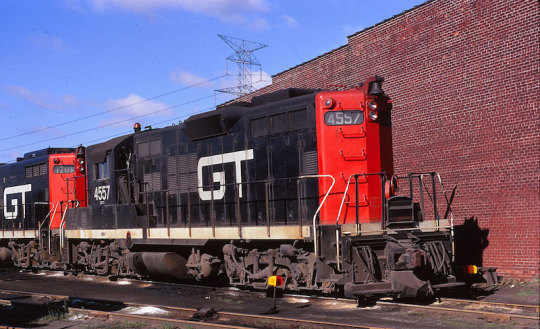
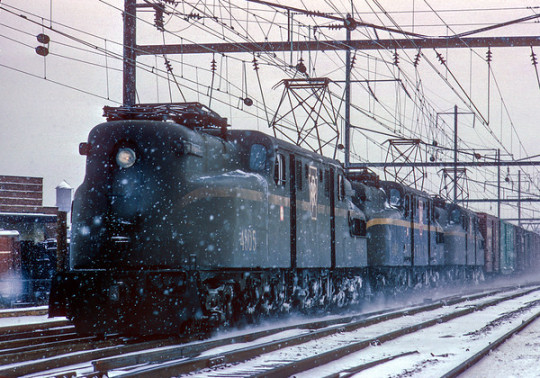
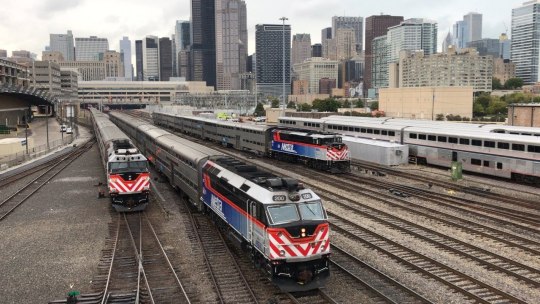


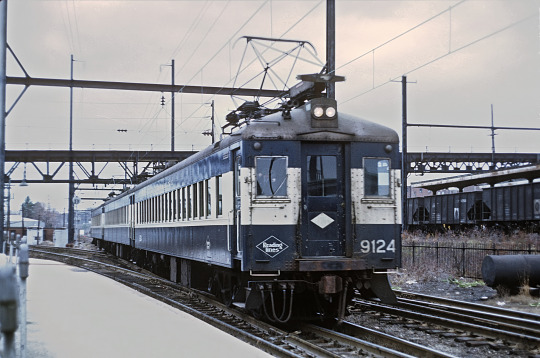
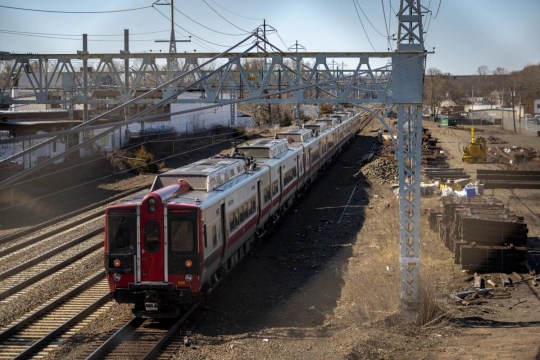
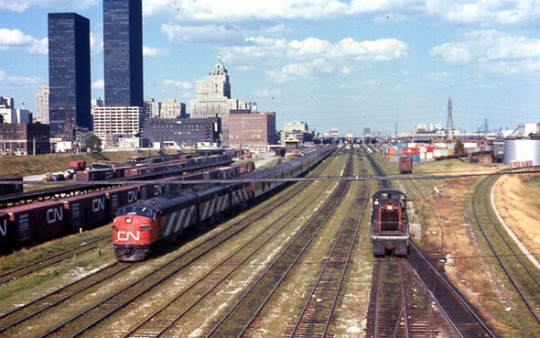
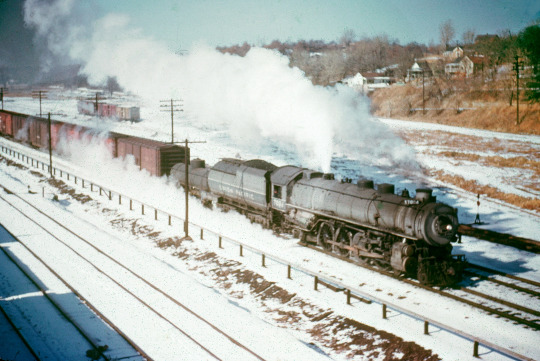
hi:
Pennsylvania Railroad 4-6-2 and GG1
Grand Trunk Western EMD GP9 (x2)
3 more PRR GG1s
Metra i think F40PH (x3(?)) + a bunch of gallery cars and also amtrak superliners in the background
Alaska Railroad EMD GP40
New York Central P-1a
Reading Company Blueliner
Metro North New Haven Line M8
CN EMD FP9(?)
Union Pacific uhhhh idk steam locomotives are hard
:3
18 notes
·
View notes
Text
Misty Island: Thunderstruck!
Guess who's back with his wacky crossover AU?!?! ME!!!!!!

Made a proof of concept logo in paint 3D lol
(Misty Island Logo credit goes to Percyfan94 on DeviantArt!)
Anyways, this post is mainly to celebrate one thing:
I GOT MY BASH & DASH MODELS TO WORK AGAIN YIPPEE!!!!!!!!!
I now have collected all four (4) idiots ❤️

"Shake! Shake! Make me Quake!"
"OH GOD THIS WASN'T MADE FOR AN ENGINE OF MY SIZE-"

I also have Electra's consist he'll typically be running around Misty Island with! It consists of a generator car to supply him with power to move and a match wagon for coupling to chain-link stock. He despises both cars lol, espescially as the GG1s are of PRR kin and the generator car is from the New York Central, the PRR's main rival.

So, yeah! thats all the updates I have on this silly lil au of mine! Hope you enjoy!
#busted sidetalk#misty island thunderstruck#the logging locos#ttte#starlight express#electra starlight express#misty island rescue#thomas and friends
7 notes
·
View notes
Note
What's your favorite train
Your simple question has multiple answers so I'll give you those.
First, in terms of North American Steam locomotives, I probably like the PRR T-1 and NYC Dreyfuss Hudson about the same. For Diesel, the GP30 is just delightful. For Electric, the GG1 is unparalleled.
In terms of global, I particularly like Japanese steam. It looks like what British steam should have looked like. The JGR class 8620 is particularly nice.
An extra shout out to some particular locomotives, the SBB class E 3/3 is lovely. Choshi's DeKi 3 is adorable, and the USRA Mikado and its clones are very handsome.
7 notes
·
View notes
Text
Some researchers are here today and one of them mentioned that GG1s are his all-time favorite and I beamed this massive smile and gleefully said "Me too!" and proceeded to show them my bag, which is filled with GG1 pins, and for a few seconds I felt completely understood and acceptable and told a real live person that I own socks with Old Rivets on them and wasn't met with confusion.
I need to be around other train people more often, it's so healing.
15 notes
·
View notes
Text
A couple of days ago, I made a post going over the new additional engines to my TTTE OC roster of engines of the New York Central. Now this post will go over the new additional engines to my TTTE OC roster of engines of the Pennsylvania Railroad… as well as the type of engines they are. And these new additional engines are…

Glenn - brunswick green 5-stripe GG1 #4927

Gracie - tuscan red 5-stripe GG1 #4877

Garrison - brunswick green 5-stripe GG1 #4919

Gaby - tuscan red 5-stripe GG1 #4913

Eden - E44 #4453

Emma - E44 #4461

Ethan - E44 #4432

Tyler - J1a #6448

Taylor - J1a #6468

Galen - GP7 #6553

Gerry - GP7 #8799

Graydon - GP7 #8550
And so those are the new additional engines to my TTTE OC roster of engines from the Pennsylvania Railroad. And don’t worry, there will be future posts going over the backstories of these new engines, so stay tuned for that.
#pennsylvania railroad#prr#train#trains#railroad#railroads#rail#rails#electric locomotive#gg1#steam locomotive#diesel locomotive#ttte oc#ttte#thomas and friends#thomas the tank engine#passenger cars#passenger train#freight train#freight cars
9 notes
·
View notes
Video
Washington, D.C., 26AUG'67
PRR "Executive" at Union Station, behind GG1 (4905.)
#executive#prr#pennsylvania railroad#1967#new york city#washington dc#trains#passenger train#history#washington dc union station
21 notes
·
View notes
Text
Explore the Exciting World of Electric Trains with High Voltage DLC

High Voltage DLC is due to make its way onto Railway Empire 2 which is playable on Steam Deck and Linux via Windows PC. Thanks to the brilliant team at Gaming Minds Studios. Due to make its way onto Steam.
Big news from Kalypso Media and Gaming Minds Studios – the new DLC, Railway Empire 2 – High Voltage, is sparking its way to your screens on July 30th. Coming to Linux and Steam Deck (Verified) via Windows PC. It's time to electrify your railway empire.
In High Voltage, you'll dive into the exciting world of electric trains. Due to leave those old steam engines in the dust. This DLC is packed with great new content, like 10 historically accurate electric locomotives. Leading the charge are the PRR GG1 Blackjack and Ce 6/8 III Krokodil, true legends of railway tech from the early 20th century.
Railway Empire 2 | Release Trailer
youtube
You'll also get to explore the stunning Swiss countryside and race through Europe on a brand-new map – Switzerland. This map isn't just about the views; it's also about the cargo. You’ll be transporting 10 new goods, including Swiss Pocket Knives, Herbal Candies, and even Cheese Fondue. These unique items will boost your revenue like never before.
Take control in two new scenarios – High Voltage and Power to the People. In these, you'll master the art of high-speed, efficient train travel, ensuring your passengers and goods get where they need to be quickly and profitably.
What’s New in High Voltage?
The Age of Electrification: Step into a new era as electric trains start due to take over from steam giants. Get ready for some serious speed and efficiency upgrades.
Fully Charged Locomotives: You’ll have 10 carefully recreated electric locomotives at your disposal. So you can experience the power of the Ce 6/8 III Krokodil and the PRR GG1 Blackjack. Plus, enjoy 3 new electronic locomotive sounds that bring these machines to life.
New Scenarios: The DLC also features two fully voiced scenarios, "High Voltage" starting in 1914, and "Power to the People" beginning in 1920. These challenges will test your skills as you navigate the shift to electric power.
Swiss Expansion: Expand your empire across the middle of Europe with the new Switzerland regional map. Since you can play it as one large map or in five detailed sections.
Unique Swiss Goods: Transport iconic Swiss products like Pocket Knives, Herbal Candies, and Cheese Fondue. These new items add variety and profit potential to your routes.
Fresh Tunes: Get into the groove with 20 new music tracks and jingles. They’re designed to immerse you in the high-energy world of electric trains.
Railway Empire 2 – High Voltage is due to hit Steam on July 30th. Mark your calendars and get ready to power up your railway empire. Playable on Linux and Steam Deck (Verified) via Windows PC.
So, if you're ready to jump into the future of railroads, this content is for you. It’s packed with everything you need to take your game to the next level. Don’t miss out the base title, on sale via Steam (20% off) and Humble Store (15% off). Dropping the price to roughly $39.99 USD / £36.79 / 39,99€.
#railway empire 2#high voltage#dlc#linux#gaming news#gaming minds studios#ubuntu#steam deck#windows#pc#Youtube
0 notes
Text

"North America's first compliant, self-powered, zero-emission passenger train-"
BULLSHIT



From top to bottom:
PRR AA1, built: 1905
B&O No. 2, built: 1895
PRR GG1, built: 1934
You cannot in GOOD FAITH tell me that you supposedly invented some "zero emission passenger train" when ACTUAL ZERO EMISSION TRAINS WERE RUNNING AS FAR BACK AS OVER A CENTURY AGO
Fucking ridiculous.
Expect a Train Talk Tuesday on Hydrogen trains because its well past the time I rip into these for being the scams they are.
0 notes
